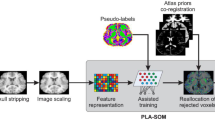Abstract
Image segmentation is very important in computer based image interpretation and it involves the labeling of the image so that the labels correspond to real world objects. In this study, we utilise a novel approach to automatically segment out the ventricular system from a series of MR brain images and to recover the shape of hand outlines from a series of 2D training images. Automated landmark extraction is accomplished through the use of the self-organising model the growing neural gas (GNG) network which is able to learn and preserve the topological relations of a given set of input patterns without requiring a priori knowledge of the structure of the input space. The GNG based method is compared to other self-organising networks such as Kohonen and Neural Gas (NG) maps and results are given showing that the proposed method preserves accurate models.
Preview
Unable to display preview. Download preview PDF.
Similar content being viewed by others
References
Baumberg, A., Hogg, D.: Learning flexible models from image sequences. In: 3rd European Conference on Computer Vision, vol. 1, pp. 299–308 (1994)
Davies, H.R., Twining, J.C., Cootes, F.T., Waterton, C.J., Taylor, J.C.: A minimum description length approach to statistical shape modeling. IEEE Transaction on Medical Imaging 21, 525–537 (2002)
Thodberg, H.H., Olafsdottir, H.: Adding curvature to minimum description length shape models. In: 14th British Machine Vision Conference, vol. 2, pp. 251–260 (2003)
Ericsson, A., Åstróm, K.: Minimizing the description length using steepest descent. In: 14th British Machine Vision Conference, vol. 2 (2003)
Fatemizadeh, E., Lucas, C., Soltania-Zadeh, H.: Automatic landmark extraction from image data using modified growing neural gas network. IEEE Transactions on Information Technology in Biomedicine 7(2), 77–85 (2003)
Angelopoulou, A., Psarrou, A., García, J., Kenneth, R.: Automatic landmarking of 2d medical shapes using the growing neural gas network. In: Liu, Y., Jiang, T.-Z., Zhang, C. (eds.) CVBIA 2005. LNCS, vol. 3765, pp. 210–219. Springer, Heidelberg (2005)
Cootes, T.F., Taylor, C.J., Cooper, D.H., Graham, J.: Training models of shape from sets of examples. In: 3rd British Machine Vision Conference, pp. 9–18 (1992)
AL-Shaher, A., Hancock, R.E.: Learning mixtures of point distribution models with the EM algorithm. The Journal of Pattern Recognition 36, 2805–2818 (2003)
Kohonen, T.: Self-organising maps. Springer, Heidelberg (2001)
Ritter, H., Schulten, K.: Topology conserving mappings for learning motor tasks. In: Neural Networks for Computing, AIP Conf. Proc. (1986)
Martinez, T., Ritter, H., Schulten, K.: Three dimensional neural net for learning visuomotor-condination of a robot arm. IEEE Transactions on Neural Networks 1, 131–136 (1990)
Nasrabati, M., Feng, Y.: Vector quantisation of images based upon kohonen self-organizing feature maps. In: IEEE Int. Conf. Neural Networks, pp. 1101–1108 (1988)
Fritzke, B.: A growing neural gas network learns topologies. Advances in Neural Information Processing Systems, 625–632 (1995)
Geoffrey, J., Goodhill, F., Terrence, J.: A unifying measure for neighbourhood preservation in topographic mappings. In: Proceedings of the 2nd Joint Symposium on Neural Computation, vol. 5, pp. 191–202 (1997)
Martinez, T.: Competitive hebbian learning rule forms perfectly topology preserving maps. In: ICANN (1993)
Martinez, T., Schulten, K.: Topology representing networks. The Journal of Neural Networks 7, 507–522 (1994)
Author information
Authors and Affiliations
Editor information
Editors and Affiliations
Rights and permissions
Copyright information
© 2006 Springer-Verlag Berlin Heidelberg
About this paper
Cite this paper
Rodríguez, J.G., Angelopoulou, A., Psarrou, A., Revett, K. (2006). Automatically Building 2D Statistical Shapes Using the Topology Preservation Model GNG. In: Narayanan, P.J., Nayar, S.K., Shum, HY. (eds) Computer Vision – ACCV 2006. ACCV 2006. Lecture Notes in Computer Science, vol 3851. Springer, Berlin, Heidelberg. https://doi.org/10.1007/11612032_53
Download citation
DOI: https://doi.org/10.1007/11612032_53
Publisher Name: Springer, Berlin, Heidelberg
Print ISBN: 978-3-540-31219-2
Online ISBN: 978-3-540-32433-1
eBook Packages: Computer ScienceComputer Science (R0)




